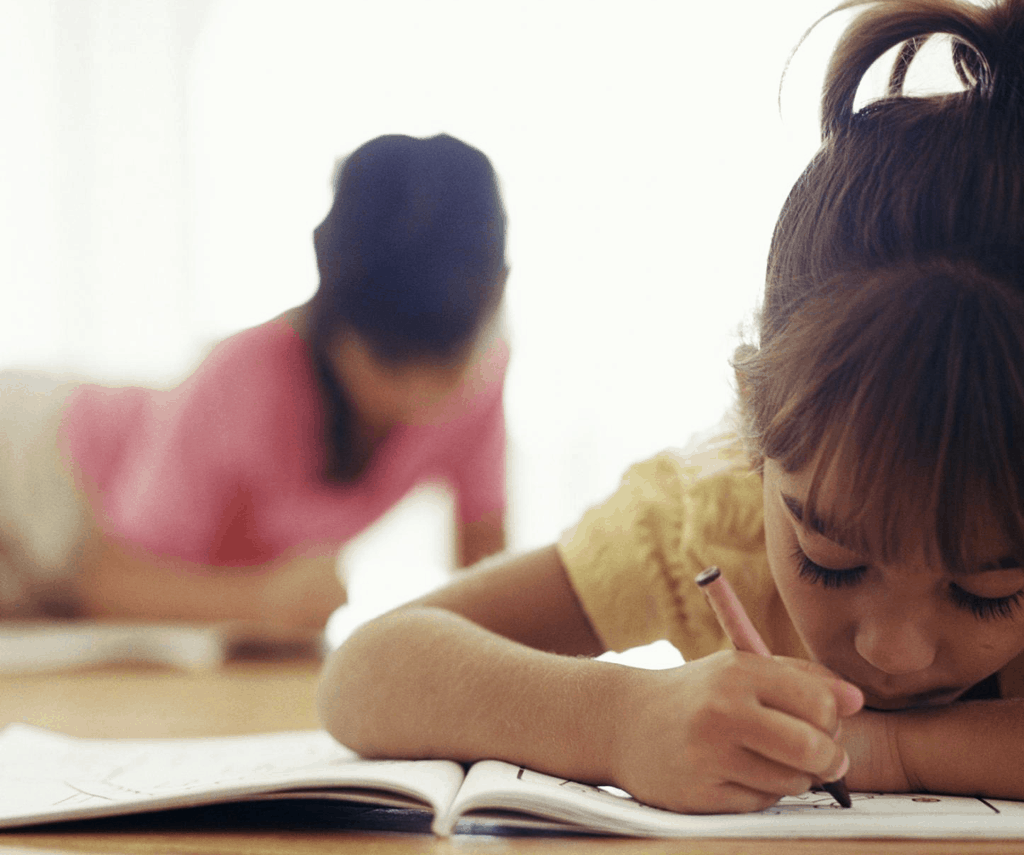One of the best ways to prepare your students for a rich school career is by teaching them social-emotional skills. Mindfulness activities are a simple, enjoyable way for everyone from young children to older students to learn these skills. Rooted in Eastern spirituality and psychological research, mindfulness is proven to transform our brains in a way that leads to better grades and coping skills.
But the benefits of mindfulness in schools extend to educators, too. Stressed teachers often feel overwhelmed and ineffective in classroom management. But by practicing mindfulness, teachers can learn emotional regulation techniques that change the way they view their jobs and interact with their students. Both their psychological health and classroom environment improve by practicing mindfulness.
How can you use the benefits of mindfulness to your school’s advantage? Read on to learn what mindfulness is and how it changes the way our brains respond to stressful situations. Then, find tips for implementing mindfulness activities with your students and as an educator.
What is Mindfulness?

But what does “mindful” mean, and how can you use mindfulness in the classroom? Mindfulness refers to the process of focusing your attention in the present. It involves a moment-by-moment awareness of sensations, thoughts, and feelings that you experience. The idea of a mindful mindset is to help ground yourself in your surroundings while dealing with stressful or overwhelming experiences.
One of the most important components of mindfulness is not only awareness but an attitude of acceptance and curiosity towards your thoughts and emotions.[3] Mindfulness activities can help you find the roots behind stress, anxiety, or other negative feelings. By recognizing these feelings for what they are and accepting them, you can better overcome psychological distress. Anyone, from children to adults, can find a greater peace of mind through mindfulness techniques.
In terms of curriculum, mindfulness falls under the umbrella of social-emotional learning (SEL). While schools traditionally focus on academic instruction, social-emotional development is just as crucial for student success. According to a meta-analysis of 207 studies, classroom SEL programs can result in an 11% increase in academic achievement, 25% improvement in social skills, and 10% decrease in misbehavior or mental health issues.[4] Mindfulness can be a fun, effective way for teachers to help students develop these skills.
Why Mindfulness Techniques Can Retrain Your Brain

Mindfulness can also affect the amount of grey matter in your brain. In your hippocampus, for example, mindful activities increases grey matter density–which can strengthen your memory, compassion, introspection, and self-awareness.[7] These activities can also decrease the amount of brain matter in your amygdala, which reduces stress and anxiety.[8] Not only do mindful techniques strengthen your brain’s ability to learn positive coping strategies, but they lower the power and frequency of negative emotions.
Even in small doses, mindfulness for students can lead to promising results. Just practicing mindfulness for half an hour a day or less for eight weeks can lead to noticeable cognitive changes.[9] And while it’s true that most brain imaging studies focus on adult patients, researchers believe that the results are positive across all ages. Not only is mindfulness one of the most popular anxiety relief strategies for elementary students but, according to neuroscience, it’s also the most effective.[10]
Benefits of Mindfulness in the Classroom
The benefits of mindfulness for students range from academic to social-emotional improvements. Students who receive mindfulness training in class generally have higher test scores and grades than their peers.[11] The more they practice mindful activities, the more their focus, social skills, self-esteem, and ability to regulate their emotions improve, too.[12] Plus, students who learn mindfulness often have healthier sleep schedules and are better prepared for their day inside and outside of the classroom.[13]
Mindfulness in schools also helps to reduce unhealthy or disruptive behavior in classrooms. For example, students who receive mindfulness training usually have lower stress levels, and they also have lower rates of anxiety or depression.[14,15] Thanks to an improved mood and better sleep habits, they’re also less likely to feel fatigued at school. Plus, bullying rates are significantly lower in schools that implement mindfulness programs.[16]
In a nutshell, mindfulness in elementary schools is proven to increase:
- Academic achievement
- Focus
- Social skills and emotional regulation
- Self-esteem
- Sleep habits
- Compassion
It is also shown to reduce:
- Stress levels
- Mental health issues
- Fatigue
- Bullying
Additionally, mindfulness programs are an effective way to reach students with disabilities. Children with learning disabilities, particularly attention-deficit hyperactivity disorder (ADHD), have higher grades and lower instances of emotional disruption after receiving mindfulness training than those who receive no training.[17] For children with special needs, mindfulness can help them learn social-emotional skills to connect with their peers.[18] By using mindfulness strategies, educators can give every student the tools they need to thrive in class.
Fun Mindfulness Activities for Students
Luckily for educators, teaching mindfulness in schools is as fun as it is effective. Students report that mindfulness group activities are enjoyable and that they use the techniques that they learned in their daily lives.[19] Try these mindfulness activities for the classroom to teach your students social-emotional skills that will help them reach their academic potential.
 Mindful Eating Activity
Mindful Eating Activity
Give each child in your class a piece of candy or other treat. As they chew it, instruct them to focus on the flavors and sensations that they notice while eating. Once they’ve finished eating, have them discuss or write down any important details they noticed about the food (like its color, smell, taste, texture, and so on).
This mindfulness activity is especially useful for teaching students about the five senses. If you’re looking for social-emotional activities that connect with your school’s existing curriculum, this can be a great tie-in.
Mini Meditation [20]
Because children have shorter attention spans, small-scale meditation activities are better for teaching mindfulness without making them bored. One way to do this is putting on calming music and having students close their eyes at their desks. Instruct students to close their eyes and focus on the music as much as possible. If their thoughts wander from the music, remind them not to get mad at themselves but to just recognize what happened and return to the music.
For early elementary school students, aim for two to three minutes at the most. Older students may be able to meditate longer as they have more practice.
Body Scan [21]
This activity is a great way to help students use mindfulness techniques as a stress management tool. To start the body scan, have your students lie down on the floor or sit still at their desks. Walk them through an inventory of any emotions or sensations they notice from their head to their toes. As they recognize these feelings, instruct them to accept their presence and then move on to the next part of their body.
For a more involved mindfulness exercise, have your students lie on the floor. Walk them through a scan of any feelings or sensations they have from their head to their toes. Instruct them to, as they notice these feelings, accept them as they are. Once you’ve finished the body scan, take a few deep breaths together and conclude the activity.
Walking Meditation
Walking meditations are a fun way to help students get their wiggles out while practicing mindfulness. Take your students outside and go for a brief, five-to-ten-minute walk. While walking, ask them to focus on the sights and sounds around them, as well as how they feel. After completing the exercise, take them back inside and have them reflect on the experience through discussion or journaling.
How to Practice Mindfulness for Teachers
Mindfulness can improve stress management for teachers just as much as it does for students. Educators at the University of California, Berkeley believe that teachers who practice mindfulness are more capable of understanding their own emotions, developing good teacher-student relationships, and establishing a positive classroom environment.[22]
But most importantly, mindfulness is a self-care strategy for teachers that can help them feel fulfilled and improve their overall well-being.[23]
Use these five tips on how to be mindful as an educator and reap the benefits for yourself and for your students:
- Before class starts each day, take five to ten minutes and put on a recorded meditation or practice a few breathing exercises
- Start keeping a journal and try to write in it at least a few times a week. Keeping track of your experiences can help you recognize thoughts and feelings as they come during the day
- To make mindfulness a part of your routine, set daily reminders on your phone to do a mindful activity [24]
- Gratitude is a great way to become more mindful while cultivating a positive attitude. Once a day, try to make a mental list of ten different things that you’re thankful for
- For a mindfulness activity that involves your body as much as your mind, join a yoga class or do a few poses in the morning before your classes begin
Sources:
Leland, M. Mindfulness and Student Success. Journal of Adult Education, 2015, 44(1), pp. 19-24.[1]
Shonin, E., Gordon, W.V., and Griffiths, M.D. Practical tips for using mindfulness in general practice. British Journal of General Practice, 2014, 64(624), pp. 368-69.[2]
Greater Good Magazine. Mindfulness Definition: What Is Mindfulness? Retrieved from portland.edu: https://greatergood.berkeley.edu/topic/mindfulness/definition.[3]
Durlak, J. A., Weissberg, R.P., Dymnicki, A.B., Taylor, R.D. and Schellinger, K. The impact of enhancing students’ social and emotional learning: a meta-analysis of school-based universal interventions. Child Development, 2011, 82(1), pp. 405-32.[4]
Davidson, R. and Lutz, A. Buddha’s brain: neuroplasticity and meditation. IEEE Signal Process Mag, 2008, 25(1), pp. 174–176.[5]
Weare, K. Evidence for the Impact of Mindfulness on Children and Young People. Mindfulness in Schools Project, April 2012, pp. 1-12.[6]
Hölzel, E. Mindfulness practice leads to increases in regional brain gray matter density. Psychiatry Research Neuoroimaging, 2011, 191(1), pp. 36.[7]
Ibid.[8]
Weare, K. Evidence for the Impact of Mindfulness on Children and Young People. Mindfulness in Schools Project, April 2012, pp. 1-12.[9]
Gethin, R. On some definitions of mindfulness. Contemporary Buddhism: An Interdisciplinary Journal, 2012, 12(1), pp. 263-79.[10]
Franco, C., Mañas, I., Cangas, A.J., and Gallego, J. The Applications of Mindfulness with Students of Secondary School: Results on the Academic Performance, Self-concept and Anxiety. University of Almería Department of Education, 2010, pp.83-97.[11]
Meiklejohn, J., Phillips, C., Freedman, M.L., Griffin, M.L., Biegel, G., Roach, A., Frank, J., Burke, C., Pinger, L., Soloway, G., Isberg, R., Sibinga, E., Grossman, L., and Saltzman, A. Integrating Mindfulness Training into K-12 Education: Fostering the Resilience of Teachers and Students. Mindfulness Journal, December 2012, 3(4), pp. 291-307.[12]
Weare, K. Evidence for the Impact of Mindfulness on Children and Young People. Mindfulness in Schools Project, April 2012, pp. 1-12.[13]
Napoli, M.N. et. al. Mindfulness Training for Elementary School Students, pp. 99-125.[14]
Meiklejohn, J. et. al. Integrating Mindfulness Training into K-12 Education: Fostering the Resilience of Teachers and Students, pp. 291-307.[15]
Leland, M. Mindfulness and Student Success. Journal of Adult Education, 2015, 44(1), pp. 19-24.[16]
Ibid.[17]
Benn, R., Akiva, T., Arel, S., and Roeser, R. W. Mindfulness training effects for parents and educators of children with special needs. Developmental Psychology, 2012, 48(5), pp. 1476-87.[18]
Mapel, T. Mindfulness and education: Students’ experience of learning mindfulness in a tertiary classroom. New Zealand Journal of Educational Studies, 2012, 47(1), pp. 19-32.[19]
Concordia University Department of Education. Mindfulness Activities for the Elementary Classroom. Retrieved from portland.edu: https://education.cu-portland.edu/blog/classroom-resources/mindfulness-activities-kids-classroom/.[20]
Hooker, K.E., and Fodor, I.E. Teaching Mindfulness to Children. Gestalt Review, 2008, 12(1), pp. 75-92.[21]
Greater Good Magazine. How Mindfulness Can Help Teachers. Retrieved from berkeley.edu: https://greatergood.berkeley.edu/article/item/seven_ways_mindfulness_can_help_teachers.[22]
Concordia University Department of Education. Mindfulness Activities for the Elementary Classroom. Retrieved from portland.edu: https://education.cu-portland.edu/blog/classroom-resources/mindfulness-activities-kids-classroom/.[23]
Shonin, E., Gordon, W.V., and Griffiths, M.D. Practical tips for using mindfulness in general practice. British Journal of General Practice, 2014, 64(624), pp. 368-69.[24]
Ibid.[25]


